Six North Faces of the Alps: Matterhorn
By Stuart McAleese, IFMGA Mountain Guide and Glenmore Lodge Instructor
The North Face of the Matterhorn
Schmidt Route
Time taken: 2 days
Climbing team: Rich Cross and Graham Frost (both total heros and world class alpine mountaineers and climbers – IFMGA Mountain Guides)
With thanks to IFMGA Mountain Guide Tim Neill for some of the great photos you see used here.
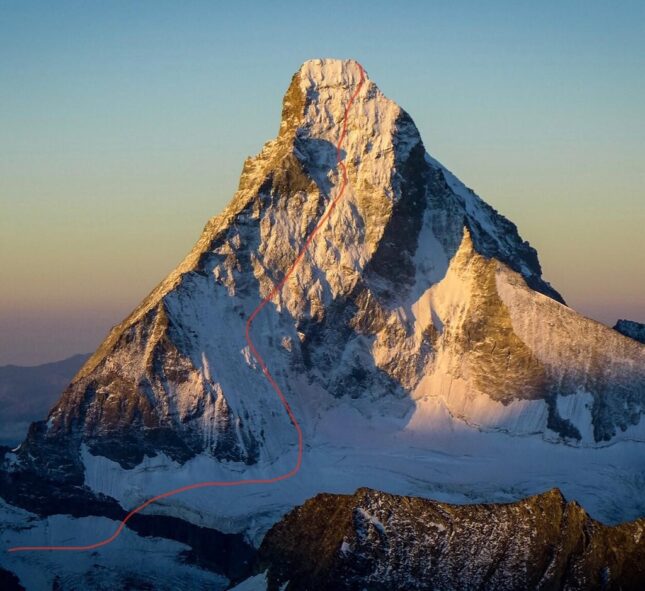
Photo credit: IFMGA Mountain Guide Tim Neill
Relaxing in Chamonix valley, I was fresh off an ascent of The Shroud on the Grandes Jorasses with my friend Rich Cross. We’d only landed a few days ago, having gone straight from the plane, to the station carpark to pack and then after an overnight in the station, on to our route, so we had felt the effects of a lack of acclimatisation. However we’d been successful and we were happy. But even as we had been descending down the Mer de Glace, tired but happy from this climb, our conversations had turned to ‘what next’? We had a few days left of our trip and wanted to maximise any mountain opportunities.
Back in the valley looking at online reports/chatting with friends, we heard that the North Face of the Matterhorn had just been climbed. The weather looked a little better further East in Switzerland and we called our friend Graham Frost, who lives in Switzerland. Chatting with Graham, looking to find out more about the North Face, Graham was also excited that the North Face had just been climbed too. When he said he was interested in the route, we invited him along. It is a big route and it is always fun climbing as a team of 3.
We all knew of the North Face and had all worked as Mountain Guides on the Matterhorn, often climbing the Hörnli Ridge in the summer season. However the North Face was a different challenge and involved mainly snow/ice and mixed climbing throughout, and at altitude. The route is around 1200m long and summits at 4477m, so with the bulk of the climbing around 4000m and being fresh from the plane with minimal acclimatisation, it was going to require quite a bit of hard work and effort.
Excited for the challenge we used our experience and judgement to plan and pack for the mission. Aiming to go as light as possible we focused on a 1 to 2-day ascent, with the possibility of a bivouac in the Solvay refuge. Good conditions had been reported from recent ascents and teams had climbed the route in a day.
We met Graham in Tasch and did some final rucksack packing in the huge car park there, it seemed to be the theme of the week – packing for climbing adventures in car parks… guess they were warm, dry and quiet, that time of year.
.
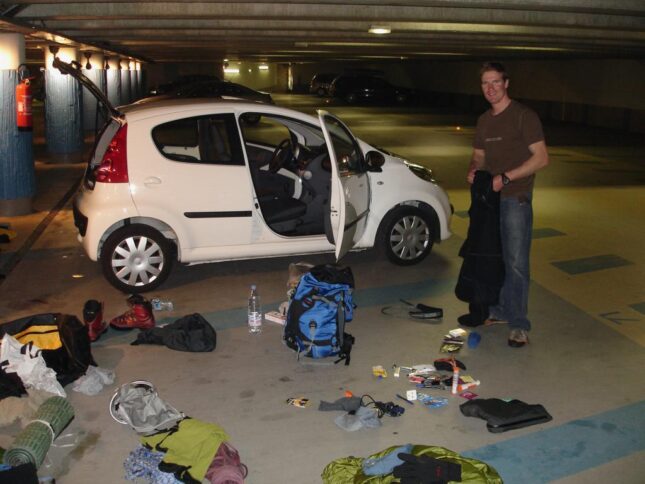
Photo credit IFMGA Mountain Guide Rich Cross
.
Soon we were in Zermatt, looking up at the Matterhorn and walking out of the village to the cable car system. The upper section of the cable car was closed so we had to take an alternative to the lower station. Any help we could get at this point was welcome, and with heavy bags we had to walk a little further than anticipated to reach the Hörnli Hut.
The hut was closed but its winter room was open – a section of most mountain huts that is left open during the winter months. There is usually blankets and a cooking area to use, basic and sometimes pretty cold but providing amazing shelter from the elements in winter. We enjoyed the walk in and there was plenty of time to relax and get ready for the early start in the morning. In the late afternoon once we had settled into the hut, we had a little walk to recce the start of the climb and the access route to the North Face. All looked good and was going to involve a section of ice climbing to access the start of the route. The actual North Face is out of sight from the hut so we could only see as far as the access section to the North side of the mountain. What we could see was our intended descent – the Hörnli ridge. This looked ok but was in different conditions to normal summer condition as it was covered with snow.
.
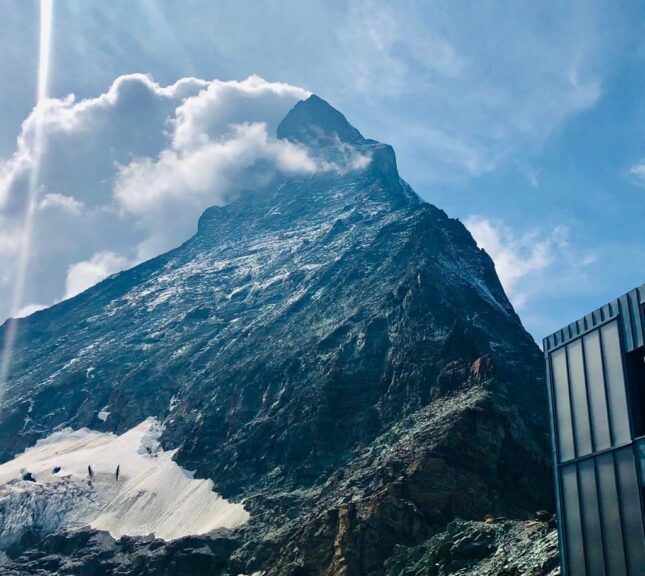
The Hörnli Ridge in summer
We agreed that it was going to be harder than normal given the snow and ice but felt that with our combined experience we could cope with the ridge as a descent, all being it may take longer.
The weather looked settled and matched the forecast; getting cold and late outside we agreed we’d seen enough and went back into the hut. After a little food we did all our evening equipment preps for a mega early start and chatted over logistics and an alarm time. Same as most other longer routes we were going to block lead whenever we could and try our best to have stints of time leading rather than changing every pitch. We also opted to use only one climbing rope, as the climb wasn’t too technical. We felt this may help rope and belay management having 1 x 60 full rope. This meant the two seconds in this case would be tied a distance apart on the bottom of the rope and the leader would only climb on a single line. Our hope was that this would keep the climbing simpler for the leader on the steep snow and ice slopes. That being said, it was a thick diameter and pretty durable full weight rope. Just in case, one of the seconds would be carrying 60m of lighter rope, to be used in case we had to make an abseil retreat for any reason.
To share the weight the other second was to carry the stove, fuel, and any other extra food. No sleeping bags were taken, only bivvy bags each and a down jacket. Our plan and approach kit wise matched our experience and the weather/conditions on the mountain and the fact there was the Solvay hut on the Hörnli ridge if shelter was required on descent. Hoping and planning on climbing the route in a day we needed an early start, so a 02:00am alarm was set.
02:00am came round quickly and we could hear the wind had picked up during the night. Rich looked outside and it seemed to be snowing a little too. It’s always easy to stay in bed a bit longer, so we agreed to give it 40 minutes and see if things improved. Weather and things always seemed to look worse in the dark, I guess that’s just one of those things.
40 minutes went and it was now or never…the weather hadn’t really improved, nor had it got worse, so we decided to go and have a look. We climbed out of the winter room via a ladder, into the snow and a view down to the night lights of Zermatt. It was windy and cold outside the hut but that soon decreased once we made our way round to the North Face.
After a section of ice we climbed onto the glacier around the corner and underneath the North Face. We could now look up and see the initial icefield and about half of the North Face disappearing into the dark. The stars were out but still pitch black, and our headtorches reflected off the frozen snow. In the distance we could see the bergschrund, a big crevasse at the base of the mountain, often guarding access to these big North face routes which can sometimes be impossible to climb over as they can be just too big. Fortunately, with all the late Autumn/early winter snow the bergschrund was fine to cross and soon we were climbing the first big snowfield.
This was a pretty big snowfield at the base of the climb and made for about a quarter of the route. Sometimes pitch climbing but mainly moving together with ice screws for running protection on the rope. We needed to find our exit point from this part of the climb to the ramp. The ramp itself from a distance is obvious, however from below and its access point, less so, especially in the dark. The only reference we had is that it sat beneath a steep wall and the topo described a pitch of mixed climbing to access it. The ramp made a rising traverse rightwards and gained the upper headwall and then to the summit. Our main problem right now was the dark and that we couldn’t make out the exact point to climb up and rightwards. Our headtorch beams searching for clues in the dark but all the terrain looked the same and what we didn’t want to do was make a mistake so early in the route and waste time backtracking from a possible dead end. All the climbing terrain ahead was steep and tricky mixed climbing so we all wanted to be sure with our next move.
With all 3 of us stopped at a belay towards the top of this icefield struggling to see further, we did what never feels right on such a big alpine route, and waited…
Sunrise wasn’t far off so we had a little break, feeling that it was going to be worth while long term to use the day light to confirm and keep us on route.
.
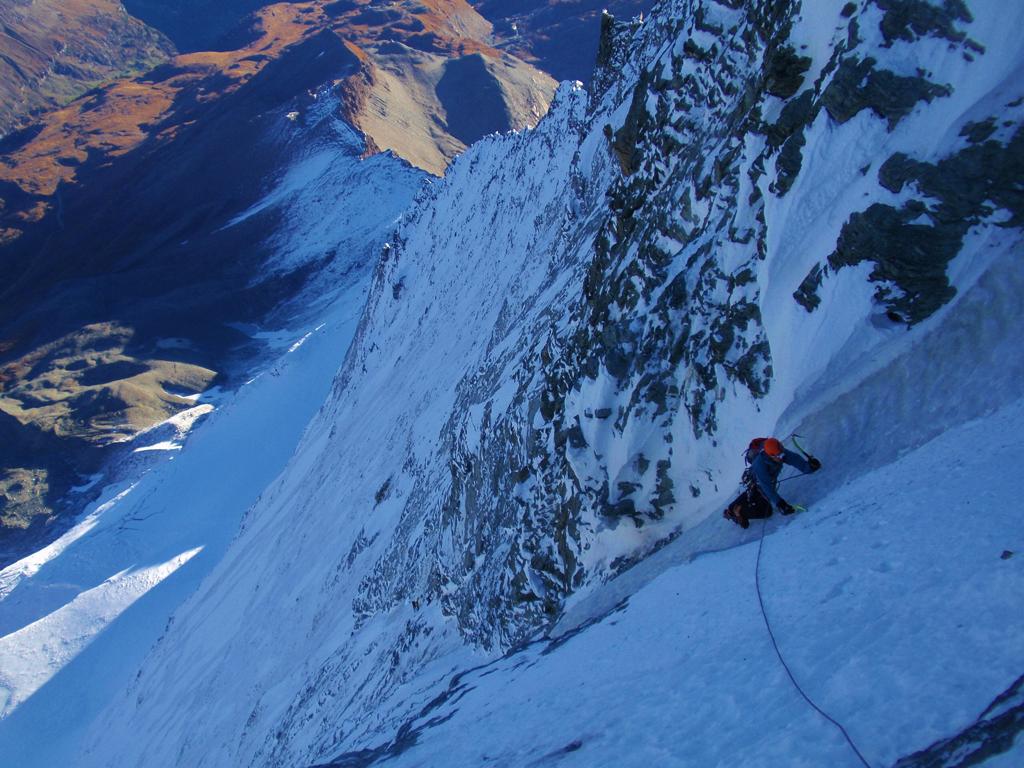
Leaving the first snowfield and starting the ramp. Photo credit IFMGA Mountain Guide Tim Neill
We all quite enjoyed the rest and had a little food/second breakfast, but soon we were eager to move. Surprised at how light it had got in such little time; we could now clearly see the ramp and the mixed climbing section too. We were right to wait and we were now close to the mixed climbing. This felt so much easier than it looked in the dark and after a couple of pitches we were at the base of the ramp.
I remember Graham taking over next and watched him lead climb off along the ramp. It all felt quite ‘north face’ now, with everything looking and feeling massive around us, cold and a little hostile in the shadows.
All of us were working hard and supporting each other whenever we can – decision making, helping with the ropes, route finding or helping get gear out of each other rucksacks whilst hanging from a belay on an icy ledge. It’s an epic effort from everyone and teamwork is key. The fun side of climbing as a three is the company on the belay, chatting and maybe even taking on some food, but your thoughts are always on the lead climber at the time. Graham was doing a superb job on his block lead and making the climbing look easy, but in fact it was exposed and quite delicate at times. Climbing all the time in our crampons and ice axes there were sections where you would have mixed climbing on rock, using similar techniques you would on a Scottish mixed climb in winter.
We were the only team on the North Face that day and we were about halfway on the route now at the end of the ramp. We were around 4000m now and it was starting to get quite cold, so we paused at a belay and all put our down jackets on, had some food and thought about the route ahead. No sandwiches up here unfortunately, only quick food like salami, cheese, cereal bars, haribo and the odd power gel.
.
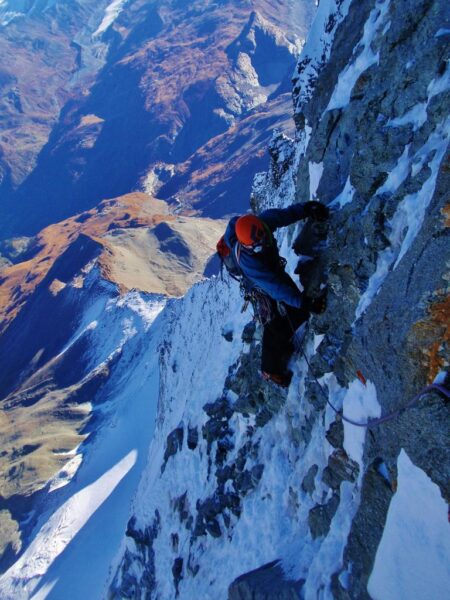
Climbing on the North Face of the Matterhorn, photo credit IFMGA Mountain Guide Tim Neill
Unsure exactly of our position on the North Face we were faced with a couple of options on which way next, so a quick look and a read of the description, hoping it would help. It didn’t help as much as we hoped, and like many times before, sometimes all you have to go on is experience, judgement, and gut feeling.
In front of us leading leftward was an easy angled ice sheet that showed little evidence of previous recent ascents, so we opted to head right into further steep mixed climbing. Rich took over and left the belay and was immediately into steep climbing. Rich is a strong climber and was doing well and before we knew it he was at a belay and our rope came tight ‘climb when you’re ready!’
The climbing was now quite full on and we all agreed when we got to the belay that the climbing had just got harder. Suspecting that we had gone ‘off route’ Rich decided to keep climbing hoping things would ease off soon. We slowed down and the climbing didn’t ease off. We tried our best to try and figure out exactly where we were and gathered we were climbing the headwall direct. There were signs of previous climbs along the way such as pitons, old cord and some belays but we all agreed after a few consecutive hard climbing pitches that we were on some headwall variation and maybe should have taken the left option lower down, oh well…
The climbing was quite out there and fairly involved. Once over the difficulties we all reflected on how hard the climbing was and we were all impressed. Rich did an amazing job and we were now on easier terrain at the base of a long snow slope with the odd rocky step. It was getting late now and we were all feeling the fatigue after a long day climbing. Pitch after pitch of deep snow we took turns lead climbing, often stopping to belay as we were tired and needed a break.
High on the right we could see a ridge line, so we aimed for this hoping the snow would be less here. Slowly we made the ridge line and paused for break, we were high on the mountain now, it was getting dark and we had just climbed the North Face.
All that was left to do now was climb the ridge up to the summit and continue our descent. Feeling time wasn’t on our side any more we pushed on slowly. We figured we were on the top of the Zmutt ridge and we were sure the summit wasn’t far off.
Beneath us the clouds were building and with the cold sunset around us everything had a pink glow. Breathing hard with the altitude I tried to keep up, I didn’t want to slow things down and we carried on pitch climbing up the very snowy ridge.
We arrived on the summit as it was getting dark, all of us really happy to have climbed the North Face. Buzzing from the big mountain adventure and proud of the team’s achievement we did a quick high five! and soon focused on the descent. I had some quick food and put my headtorch on my helmet and braced for a long difficult descent in the dark.
Looking down a very steep and snowy Hörnli ridge in the dark we all agreed it was important to take our time and be cautious. Steep downclimbing at first and constantly looking out for belay options for security. We found the belay stakes and soon we were on the Hörnli ridge proper. It didn’t take us long to figure out we weren’t going to make the whole descent that evening, and that aiming for a bivouac in the Solvay hut was a realistic option given the conditions we were faced with.
Unable to see much in the dark and now in the clouds we searched for the abseil anchors which we knew were there somewhere. There are many high on the Hörnli ridge including fixed ropes in some sections, all are mainly for summer ascents and right now most were buried in deep snow.
After finding some of the metal stakes we started abseiling the upper part of the ridge. Initially we thought it would be a good idea to do 60m abseils, by joining our two ropes together. However this was quite slow and our ropes kept on getting caught on terrain, so we opted for shorter abseils and used only 1 rope. We were only able to abseil a short distance but had less rope admin between abseil anchors and using only one rope seemed to match the terrain we were now on.
I can’t quite remember what time it was; we reached the summit around 18:30pm so by now we had been on the mountain for around 16hrs. It was slow going descending the Hörnli Ridge and I can remember all of us thinking ‘where’s the Solvay hut?’
Even though combined we knew the Hornli ridge quite well, in the dark and in winter conditions we didn’t quite know exactly where we were and more importantly how far we had to descend to reach the Solvay hut.
We all agreed that if we kept to the ridge, we couldn’t miss it, as the hut sits on top of the ridge at quite a narrow section. It’s only small though, being the size of your average bedroom, with a small bunk bed in one corner and a tiny table in the other. It is designed and positioned there for emergency use, and/or in times like these where alpinists need shelter.
All of us were quite tired now and focusing on the job of descending safely. Just when we were really starting to doubt where we were exactly, Graham on the other end of an abseil shouted ‘I can see the Solvay’.
By following the ridge line in order not to miss the Solvay hut, our abseil almost landed us onto its roof. I remember seeing the roof of the hut in my head torch and instantly feeling relieved and happy. We stood on its little balcony, shook hands and complimented each other on our big day and getting to the hut safely. Standing on the balcony I was intrigued as I’d never seen inside the hut.
We walked into the hut, all tired and dressed in our full winter gear. We brushed off any snow outside and took our crampons off. Inside it was dark and we also noticed there was already 2 other climbers in there, maybe from climbing the Hornli Ridge? We were as quiet as possible and sorted our kit ready to sleep somewhere. It was late around 21:00/22:00 and I was looking forward to a rest, we’d been on the go for around 18hrs by now.
There wasn’t much room inside, so we all found a quiet space somewhere on the floor. It was a little damp and wooden splinters all over the floor, I guess from folk wearing crampons inside. We didn’t have sleeping bags, just an extra down jacket and a bivi bag each. I remember how quickly it got really cold inside, and soon it felt like being inside a fridge! My main worry and what prevented me from sleeping was that my feet were cold and my boots and socks were damp. In order not to wake the others, I quietly and in the dark took my boots and socks off and remember feeling the damp splintered floor of the hut on my feet. I sat and pulled my feet close and held onto them in order to try and dry them out and get warm.
An hour or so I woke up…I’d fallen asleep holding my feet but remember to my shock waking up to bare feet. My instant worry was frostbite, so I quickly held them again and tried to look at my watch and figure out how long I’d been asleep. My feet were really cold now but luckily I’d only dozed off for around 30mins, even though this had felt like ages.
Unable to sleep now, I sat there in the dark and waited for morning. At first light we got up slowly and I remember everything ached and my feet were still cold. Keen to get going we ate what little food we had left and packed our rucksacks. Soon we were outside, putting our crampons on and getting the rope ready for an abseil. We were all pretty quiet, happy for the shelter of the Solvay hut but none of us really slept well.
After a couple of abseils we were back onto mountaineering terrain and I was pleased to feel my feet starting to warm back up. The weather held and it was a nice day with clear skies, and we were all looking forward to being in the warmth of the sun.
Lower down now the terrain was easing off and with less snow now we were moving faster. The sun was starting to warm us up and we could now see the Hornli Hut, our original starting point.
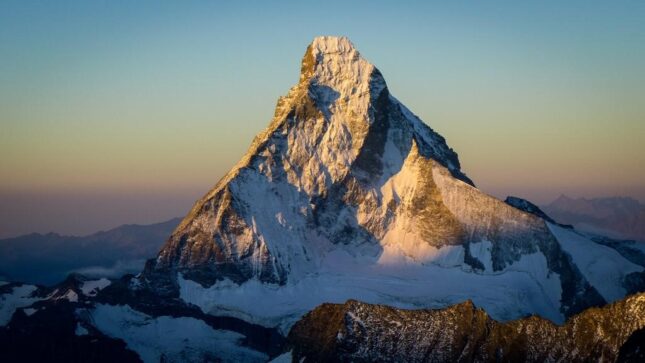
Matterhorn North Face with Hörnli Ridge on the left. Photo credit IFMGA Mountain Guide Tim Neill.
The ridge seemed to go on forever, but we all enjoyed the mountain atmosphere and how quiet it was early in the morning. During the descent we reflected on the climb and also talked about home comforts and we were all looking forward to being in the valley, even though we knew it was going to still take some time to get there. All the lift access was closed due to it being off season, so we were prepared for a long walk to Zermatt.
All aware of our fatigue and with our thoughts elsewhere we continued cautiously and soon we were downclimbing the last rock step. Climbing down the last fixed rope, we all paused at the base of the mountain and looked back up. A quick high five and handshakes all round, we were all content and pleased with our efforts.
Walking a few steps to the Hornli hut we met some other climbers who had just arrived. Word was out that the North Face was in condition and they were keen to hear our experiences on the route. We put the stove on in the hut and made a quick cup of tea and relaxed outside in the sun for a moment. I remember Rich and myself had a flight booked later that afternoon and we both chatted this over, looking down to Zermatt and considering how long the walk and everything was going to take us. It was clear that we were not going to make our flight back and I was meant to be in work tomorrow too! Over a cup of tea Rich and myself continued to talk through our options at which point Graham offered us to stay the night at his place near Arolla.
Rich phoned home about rearranging flights and I phoned work. I’m not one for missing work and I loved my job, so I was feeling a little anxious about this and hoping everything would be ok.
I was working for Plas y Brenin at the time and this was probably one of the best places in the world to understand calling in late due to climbing on the Matterhorn. Plas y Brenin were amazing about me being late and I spoke with my boss who was also a Mountain Guide, with my work rearranged he reassured us to take our time and have a safe trip home.
At the same time Rich gave me the thumbs up and confirmed our flights had been booked for the next day. With all our admin done we picked up our heavy rucksacks and started the long walk down to Zermatt. Often during the walk we would look back up to the Matterhorn and reflect on our efforts and the climb. We were all looking forward to getting down and having a good rest. Well into the evening we arrived at Grahams place and a warm welcome. We were all tired and happy after our climb and enjoyed an evening of nice food, wine and an early night.
Don’t Miss…
If you’ve enjoyed this article don’t miss out in the other articles in Stuart’s Six North Faces of the Alps series
Six North Faces: Aiguille du Dru
Six North Faces: Grandes Jorasses
About Stuart McAleese
.
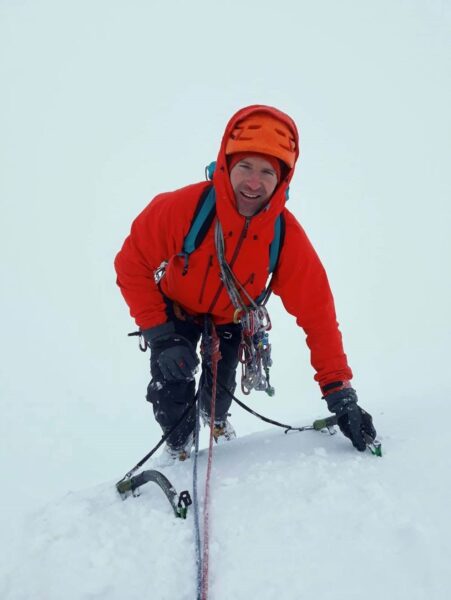
.
Originally from Northern Cumbria I started out hill walking in the Lake District when I was at school. I soon become interested in rock climbing and mountaineering, and was lucky enough to work and climb with Mountain Guides during my first job leaving school. Since then I’ve been working full time in the mountains for around 20 years.
At the same time as working, I enjoy climbing in my free time and have been lucky enough to go on many expeditions around the world, climbing new mountains, first ascents and tough remote summits. Places such as Patagonia, Alaska, Himalaya, Peru, Baffin Island, Yosemite and China. In 2004 I was nominated for the prestigious Piolet d’Or in Grenoble, France, for a 1st ascent of the ‘Supa Dupa Couloir’ in Alaska.
I love my job as a Mountain Guide, teaching and exploring big mountains in all weather all year round. I joined the Glenmore Lodge team in 2019 and head up the Summer Alpine programme.